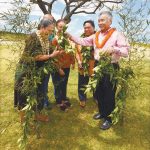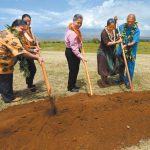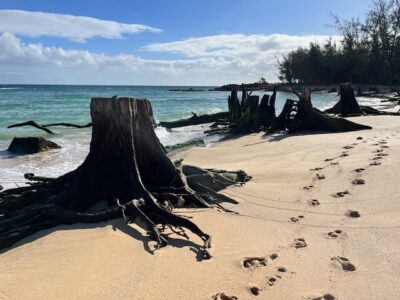‘A win, win, win’
Joint project to build home for Hawaiian homesteader
WAIOHULI — Top state officials and the Waiohuli community gathered to bless and break ground Thursday on the pilot program “Kealahou,” which provides job skills to Maui inmates who in turn will build a home for a Native Hawaiian homestead family.
“It’s kind of like putting all of this together here like a rainbow,” said Jobie Masagatani, chairwoman of the Hawaiian Homes Commission and director of the state Department of Hawaiian Home Lands, which spearheaded the project.
Kealahou or “new path” involves the DHHL, on whose land the home will be built; the University of Hawaii Maui College, which provided the education and hands-on training; and the state Department of Public Safety, which allowed Maui Community Correctional Center inmates to take part in the program.
“We here are like three leis woven together,” said Masagatani, who also noted the difficulty in getting three state departments to work together.
“What I wanted to focus on is the opportunity, (Prince) Kuhio was about creating the opportunity, not only for our families to come onto the land, but also for the people that are incarcerated, because they made a mistake, an opportunity to turn their life around. So I really want to mahalo everyone that is part of making this happen, this opportunity,” said Masagatani in one of her last appearances as the department’s leader.
Gov. David Ige, who also attended the ceremony, chose not to reappoint her to the position.
Prince Jonah Kuhio Kalaniana’ole had a vision of Native Hawaiians returning to their land when he led the fight in Congress in 1921 to pass the Hawaiian Homes Commission Act, the Hawaiian homesteading program run by DHHL.
The department manages more than 200,000 acres statewide with the specific purpose of developing and delivering homesteading opportunities for Native Hawaiians.
Ige called the project a “true milestone” and said he was proud of his departments. “This project really is the state, county, looking at the needs of the community and working together,” he said.
The DHHL is committed to having families on homelands, and Ige said this “is one more creative way to crack that nut to help our beneficiaries to afford to live on the land we have available.”
When completed, the home built by the pilot project will be offered to the next person on the DHHL list, said Cedric Duarte, DHHL’s information and community relations officer.
The Hawaiian Homes Commission approved $250,000 for the home’s construction. The applicant, who is offered the home, will have to qualify for a mortgage to purchase the home from DHHL. Once the home is paid back, DHHL will use the funds for a future project.
Ten inmates, chosen because they were nearing release, already have taken the courses needed to participate in the program. The education component involved 19 hours of basic carpentry, 12 hours of basic electric, 15 hours of basic plumbing and 10 hours of Occupational Safety and Health Administration training, Duarte said.
The cohort completed the 56-hour course from Jan 15 to Feb. 21 at the Kahului campus. The inmates received a certification of completion and an OSHA 10 Certificate from UH-Maui College.
The actual construction on the home could begin in May, pending obtaining the building permit, Duarte said. The build-out could take three to four months depending on weather conditions and availability of the inmates.
Mike Young, a UH-MC instructor and the apprenticeship and trades coordinator at the college, said there will be up to eight inmates at the site Monday through Friday. Since the completion of the classes, several of the inmates have been released from custody but still would like to join the work on the house.
On weekends, Young said students from UH-MC’s other programs, such as its apprenticeship program, also could take part in the construction.
“It’s a win, win, win, all the way around,” Young said, adding that the inmates will have the foundation to join a trade union after their release.
At the ceremony, UH-MC Chancellor Lui Hokoana said the program highlights what community colleges in Hawaii have been doing for 50 years, which is providing job training for those who need it the most. He added that giving the inmates skills to succeed can lessen recidivism.
Shari Kimoto-Kaauwai, the acting institutions division administrator for the Public Safety Department, said she had been with the department for 25 years in various roles, and they have talked about “great ideas like this.”
“Many times, we don’t see the ideas come to fruition,” she said. “For our department to see something like this is awesome.”
* Melissa Tanji can be reached at mtanji@mauinews.com.
- Untying the maile lei during Thursday’s ceremony for the Kealahou program are Hawaiian Homes Commission Chairwoman Jobie Masagatani (from left), Hawaiian Homes Commissioner Randy Awo, Department of Public Safety’s Shari Kimoto-Kaauwai, University of Hawaii Maui College Chancellor Lui Hokoana and Gov. David Ige. The Maui News / MATTHEW THAYER photos
- Taking part in Thursday’s groundbreaking ceremony for the Kealahou program are University of Hawaii Maui College Chancellor Lui Hokoana (from left), state Department of Public Safety’s Shari Kimoto-Kaauwai, Gov. David Ige, Hawaiian Homes Commission Chairwoman Jobie Masagatani and Commissioner Randy Awo.
- Maui housing advocate Blossom Feiteira speaks with Gov. David Ige before the start of Thursday’s blessing ceremony for the Kealahou program, in which Maui Community Correctional Center inmates received training at UH-Maui College and will build a home for a Native Hawaiian homesteader.






